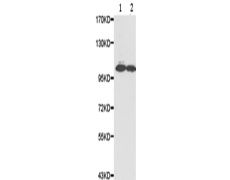|
Background: |
Lysine-specific demethylase 1 (LSD1; also known as AOF2 and BHC110) is a nuclear amine oxidase homolog that acts as a histone demethylase and transcription cofactor. Gene activation and repression is specifically regulated by the methylation state of distinct histone protein lysine residues. For example, methylation of histone H3 at Lys4 facilitates transcriptional activation by coordinating the recruitment of BPTF, a component of the NURF chromatin remodeling complex, and WDR5, a component of multiple histone methyltransferase complexes. In contrast, methylation of histone H3 at Lys9 facilitates transcriptional repression by recruiting HP1. LSD1 is a component of the CoREST transcriptional co-repressor complex that also contains CoREST, CtBP, HDAC1 and HDAC2. As part of this complex, LSD1 demethylates mono-methyl and di-methyl histone H3 at Lys4 through a FAD-dependent oxidation reaction to facilitate neuronal-specific gene repression in non-neuronal cells. In contrast, LSD1 associates with androgen receptor in human prostate cells to demethylate mono-methyl and di-methyl histone H3 at Lys9 and facilitate androgen receptor-dependent transcriptional activation. Therefore, depending on gene context LSD1 can function as either a transcriptional co-repressor or co-activator. LSD1 activity is inhibited by the amine oxidase inhibitors pargyline, deprenyl, clorgyline and tranylcypromine. |
|
Applications: |
WB |
|
Name of antibody: |
KDM1A |
|
Immunogen: |
Fusion protein of human KDM1A |
|
Full name: |
lysine (K)-specific demethylase 1A |
|
Synonyms: |
KDM1; AOF2; BHC110; KIAA0601; LSD1; KDM1A |
|
SwissProt: |
O60341 |
|
WB Predicted band size: |
95 kDa |
|
WB Positive control: |
SW480 and PC-3 cells |
|
WB Recommended dilution: |
500-2000 |

 購物車
購物車 幫助
幫助
 021-54845833/15800441009
021-54845833/15800441009
